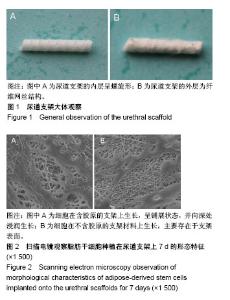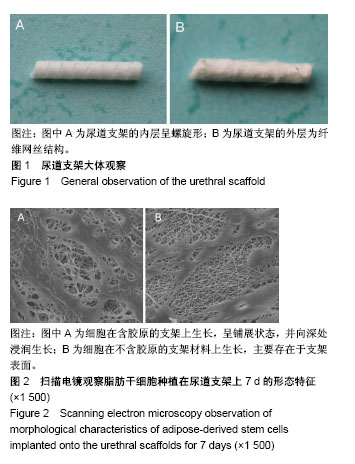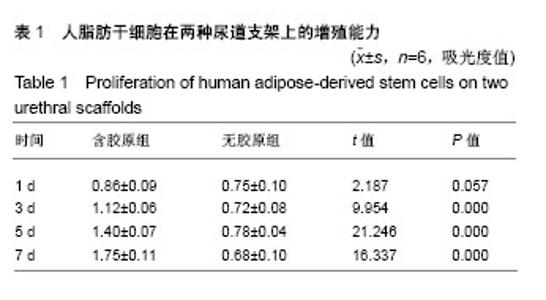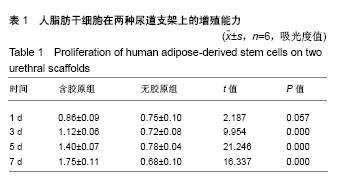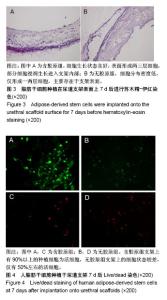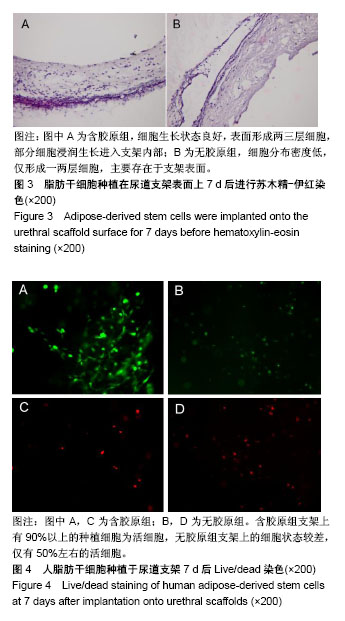Chinese Journal of Tissue Engineering Research ›› 2019, Vol. 23 ›› Issue (13): 1989-1994.doi: 10.3969/j.issn.2095-4344.1677
Previous Articles Next Articles
Construction of a tissue-engineered urethral scaffold using adipose-derived stem cells combined with biodegradable materials in vitro
Shi Jianguo, Wang Weining, Li Chunwu, Bai Xinyu, Chen Yudong
- Department of Urology, 252nd Hospital of PLA, Baoding 071000, Hebei Province, China
-
Revised:2018-12-25Online:2019-05-08Published:2019-05-08 -
Contact:Shi Jianguo, MD, Associate chief physician, Department of Urology, 252nd Hospital of PLA, Baoding 071000, Hebei Province, China -
About author:Shi Jianguo, MD, Associate chief physician, Department of Urology, 252nd Hospital of PLA, Baoding 071000, Hebei Province, China -
Supported by:the Hospital-Level Project of the 252nd Hospital of PLA, No. 2013252yy02 (to SJG)
CLC Number:
Cite this article
Shi Jianguo, Wang Weining, Li Chunwu, Bai Xinyu, Chen Yudong. Construction of a tissue-engineered urethral scaffold using adipose-derived stem cells combined with biodegradable materials in vitro[J]. Chinese Journal of Tissue Engineering Research, 2019, 23(13): 1989-1994.
share this article
| [1] Wessells H, Angermeier KW, Elliott S, et al. Male Urethral Stricture: American Urological Association Guideline. J Urol. 2017;197(1):182-190.[2] Hampson LA, McAninch JW, Breyer BN. Male urethral strictures and their management. Nat Rev Urol. 2014;11(1): 43-50.[3] Zaid UB, Lavien G, Peterson AC. Management of the Recurrent Male Urethral Stricture. Curr Urol Rep. 2016;17(4): 33.[4] Barbagli G, Lazzeri M. History and evolution of dorsal onlay urethroplasty for bulbar urethral stricture repair using skin or buccal mucosal grafts. Urologia. 2007;74(4):233-241.[5] Marzorati G, Ghinolfi G, Pachera F, et al. Bladder and buccal mucosa graft in urethral stricture reconstruction. Urologia. 2008;75(3):177-179.[6] Kumar A, Das SK, Trivedi S, et al. Substitution urethroplasty for anterior urethral strictures: buccal versus lingual mucosal graft. Urol Int. 2010;84(1):78-83.[7] O'Connell JE, Cullen IM, Murphy C, et al. Buccal mucosa urethroplasty: a 10-year retrospective review of maxillofacial and urological outcomes. Ir J Med Sci. 2015;184(4):761-767.[8] Monn MF, Waters JA, Mellon MJ. Use of rectal mucosal grafts in substitution urethroplasty: an early series. Transl Androl Urol. 2018;7(6):907-911.[9] De Kemp V, de Graaf P, Fledderus JO, et al. Tissue engineering for human urethral reconstruction: systematic review of recent literature. PLoS One. 2015;10(2):e0118653.[10] Bajek A, Gurtowska N, Olkowska J, et al. Adipose-Derived Stem Cells as a Tool in Cell-Based Therapies. Arch Immunol Ther Exp (Warsz). 2016;64(6):443-454.[11] 符伟军,史建国,王晓雄,等.人脂肪间充质干细胞诱导分化尿路上皮细胞的研究[J]. 中华实验外科杂志, 2012, 29(5) : 927-929.[12] Mangera A, Chapple CR. Tissue engineering in urethral reconstruction--an update. Asian J Androl. 2013;15(1):89-92.[13] Schofer MD, Boudriot U, Leifeld I, et al. Characterization of a PLLA-collagen I blend nanofiber scaffold with respect to growth and osteogenic differentiation of human mesenchymal stem cells. Scientific World Journal. 2009;9:118-129.[14] Osman NI, Hillary C, Bullock AJ, et al. Tissue engineered buccal mucosa for urethroplasty: progress and future directions. Adv Drug Deliv Rev. 2015;82-83:69-76.[15] Liu Y, Ma W, Liu B, et al. Urethral reconstruction with autologous urine-derived stem cells seeded in three-dimensional porous small intestinal submucosa in a rabbit model. Stem Cell Res Ther. 2017;8(1):63.[16] Wang F, Liu T, Yang L, et al. Urethral reconstruction with tissue-engineered human amniotic scaffold in rabbit urethral injury models. Med Sci Monit. 2014;20:2430-2438.[17] Li H, Xu Y, Xie H, et al. Epithelial-differentiated adipose-derived stem cells seeded bladder acellular matrix grafts for urethral reconstruction: an animal model. Tissue Eng Part A. 2014;20(3-4):774-784.[18] Ziaran S, Galambošová M, Danišovi? L. Tissue engineering of urethra: Systematic review of recent literature. Exp Biol Med (Maywood). 2017;242(18):1772-1785.[19] Larsson HM, Vythilingam G, Pinnagoda K, et al. Fiber density of collagen grafts impacts rabbit urethral regeneration. Sci Rep. 2018;8(1):10057.[20] Pinnagoda K, Larsson HM, Vythilingam G, et al. Engineered acellular collagen scaffold for endogenous cell guidance, a novel approach in urethral regeneration. Acta Biomater. 2016; 43:208-217.[21] Sartoneva R, Nordback PH, Haimi S, et al. Comparison of Poly(l-lactide-co-?-caprolactone) and Poly(trimethylene carbonate) Membranes for Urethral Regeneration: An In Vitro and In Vivo Study. Tissue Eng Part A. 2018;24(1-2):117-127.[22] Sartoneva R, Haaparanta AM, Lahdes-Vasama T, et al. Characterizing and optimizing poly-L-lactide-co-ε- caprolactone membranes for urothelial tissue engineering. J R Soc Interface. 2012;9(77):3444-3454.[23] Zhang K, Cao N, Guo X, et al. The fabrication of 3D surface scaffold of collagen/poly (L-lactide-co-caprolactone) with dynamic liquid system and its application in urinary incontinence treatment as a tissue engineered sub-urethral sling: In vitro and in vivo study. Neurourol Urodyn. 2018;37(3): 978-985.[24] Zhang K, Fu Q, Yoo J, et al. 3D bioprinting of urethra with PCL/PLCL blend and dual autologous cells in fibrin hydrogel: An in vitro evaluation of biomimetic mechanical property and cell growth environment. Acta Biomater. 2017;50:154-164.[25] Atala A, Bauer SB, Soker S, et al. Tissue-engineered autologous bladders for patients needing cystoplasty. Lancet. 2006;367(9518):1241-1246.[26] Kennedy KM, Bhaw-Luximon A, Jhurry D. Cell-matrix mechanical interaction in electrospun polymeric scaffolds for tissue engineering: Implications for scaffold design and performance. Acta Biomater. 2017;50:41-55.[27] Ingavle GC, Leach JK. Advancements in electrospinning of polymeric nanofibrous scaffolds for tissue engineering. Tissue Eng Part B Rev. 2014;20(4):277-293.[28] Li C, Xu YM, Song LJ, et al. Urethral reconstruction using oral keratinocyte seeded bladder acellular matrix grafts. J Urol. 2008;180(4):1538-1542.[29] Heller M, Frerick-Ochs EV, Bauer HK, et al. Tissue engineered pre-vascularized buccal mucosa equivalents utilizing a primary triculture of epithelial cells, endothelial cells and fibroblasts. Biomaterials. 2016;77:207-215.[30] Fu Q, Deng CL, Liu W, et al. Urethral replacement using epidermal cell-seeded tubular acellular bladder collagen matrix. BJU Int. 2007;99(5):1162-1165.[31] Orabi H, AbouShwareb T, Zhang Y, et al. Cell-seeded tubularized scaffolds for reconstruction of long urethral defects: a preclinical study. Eur Urol. 2013;63(3):531-538.[32] De Filippo RE, Kornitzer BS, Yoo JJ, et al. Penile urethra replacement with autologous cell-seeded tubularized collagen matrices. J Tissue Eng Regen Med. 2015;9(3):257-264.[33] Gu GL, Xia SJ, Zhang J, et al. Tubularized urethral replacement using tissue-engineered peritoneum-like tissue in a rabbit model. Urol Int. 2012;89(3):358-364.[34] Li Y, Wu J, Feng F, et al. A Preclinical Study of Cell-seeded Tubularized Scaffolds Specially Secreting LL37 for Reconstruction of Long Urethral Defects. Anticancer Res. 2017;37(8):4295-4301.[35] Davis NF, Cunnane EM, Mulvihill JJ, et al. The Role of Stem Cells for Reconstructing the Lower Urinary Tracts. Curr Stem Cell Res Ther. 2018;13(6):458-465.[36] 蔡炳,李科,脱颖,等.诱导多能干细胞向尿道上皮细胞分化体系的建立[J].中华腔镜泌尿外科杂志(电子版),2016, 10(3):40-43.[37] 杨旭芳,何旭,何牮,等.人脂肪干细胞向内皮分化最佳诱导体系的建立[J].中国老年学杂志,2010,30(5):611-613. [38] Li CL, Liao WB, Yang SX, et al. Urethral reconstruction using bone marrow mesenchymal stem cell- and smooth muscle cell-seeded bladder acellular matrix. Transplant Proc. 2013; 45(9):3402-3407. [39] Cao JQ, Liang YY, Li YQ, et al.Adipose-derived stem cells enhance myogenic differentiation in the mdx mouse model of muscular dystrophy via paracrine signaling.Neural Regen Res. 2016;11(10):1638-1643.[40] Tabatabaei Qomi R, Sheykhhasan M. Adipose-derived stromal cell in regenerative medicine: A review. World J Stem Cells. 2017;9(8):107-117. |
| [1] | Pu Rui, Chen Ziyang, Yuan Lingyan. Characteristics and effects of exosomes from different cell sources in cardioprotection [J]. Chinese Journal of Tissue Engineering Research, 2021, 25(在线): 1-. |
| [2] | Lin Qingfan, Xie Yixin, Chen Wanqing, Ye Zhenzhong, Chen Youfang. Human placenta-derived mesenchymal stem cell conditioned medium can upregulate BeWo cell viability and zonula occludens expression under hypoxia [J]. Chinese Journal of Tissue Engineering Research, 2021, 25(在线): 4970-4975. |
| [3] | Zhang Tongtong, Wang Zhonghua, Wen Jie, Song Yuxin, Liu Lin. Application of three-dimensional printing model in surgical resection and reconstruction of cervical tumor [J]. Chinese Journal of Tissue Engineering Research, 2021, 25(9): 1335-1339. |
| [4] | Shen Jinbo, Zhang Lin. Micro-injury of the Achilles tendon caused by acute exhaustive exercise in rats: ultrastructural changes and mechanism [J]. Chinese Journal of Tissue Engineering Research, 2021, 25(8): 1190-1195. |
| [5] | Zhang Xiumei, Zhai Yunkai, Zhao Jie, Zhao Meng. Research hotspots of organoid models in recent 10 years: a search in domestic and foreign databases [J]. Chinese Journal of Tissue Engineering Research, 2021, 25(8): 1249-1255. |
| [6] | Hou Jingying, Yu Menglei, Guo Tianzhu, Long Huibao, Wu Hao. Hypoxia preconditioning promotes bone marrow mesenchymal stem cells survival and vascularization through the activation of HIF-1α/MALAT1/VEGFA pathway [J]. Chinese Journal of Tissue Engineering Research, 2021, 25(7): 985-990. |
| [7] | Shi Yangyang, Qin Yingfei, Wu Fuling, He Xiao, Zhang Xuejing. Pretreatment of placental mesenchymal stem cells to prevent bronchiolitis in mice [J]. Chinese Journal of Tissue Engineering Research, 2021, 25(7): 991-995. |
| [8] | Liang Xueqi, Guo Lijiao, Chen Hejie, Wu Jie, Sun Yaqi, Xing Zhikun, Zou Hailiang, Chen Xueling, Wu Xiangwei. Alveolar echinococcosis protoscolices inhibits the differentiation of bone marrow mesenchymal stem cells into fibroblasts [J]. Chinese Journal of Tissue Engineering Research, 2021, 25(7): 996-1001. |
| [9] | Fan Quanbao, Luo Huina, Wang Bingyun, Chen Shengfeng, Cui Lianxu, Jiang Wenkang, Zhao Mingming, Wang Jingjing, Luo Dongzhang, Chen Zhisheng, Bai Yinshan, Liu Canying, Zhang Hui. Biological characteristics of canine adipose-derived mesenchymal stem cells cultured in hypoxia [J]. Chinese Journal of Tissue Engineering Research, 2021, 25(7): 1002-1007. |
| [10] | Geng Yao, Yin Zhiliang, Li Xingping, Xiao Dongqin, Hou Weiguang. Role of hsa-miRNA-223-3p in regulating osteogenic differentiation of human bone marrow mesenchymal stem cells [J]. Chinese Journal of Tissue Engineering Research, 2021, 25(7): 1008-1013. |
| [11] | Lun Zhigang, Jin Jing, Wang Tianyan, Li Aimin. Effect of peroxiredoxin 6 on proliferation and differentiation of bone marrow mesenchymal stem cells into neural lineage in vitro [J]. Chinese Journal of Tissue Engineering Research, 2021, 25(7): 1014-1018. |
| [12] | Zhu Xuefen, Huang Cheng, Ding Jian, Dai Yongping, Liu Yuanbing, Le Lixiang, Wang Liangliang, Yang Jiandong. Mechanism of bone marrow mesenchymal stem cells differentiation into functional neurons induced by glial cell line derived neurotrophic factor [J]. Chinese Journal of Tissue Engineering Research, 2021, 25(7): 1019-1025. |
| [13] | Duan Liyun, Cao Xiaocang. Human placenta mesenchymal stem cells-derived extracellular vesicles regulate collagen deposition in intestinal mucosa of mice with colitis [J]. Chinese Journal of Tissue Engineering Research, 2021, 25(7): 1026-1031. |
| [14] | Pei Lili, Sun Guicai, Wang Di. Salvianolic acid B inhibits oxidative damage of bone marrow mesenchymal stem cells and promotes differentiation into cardiomyocytes [J]. Chinese Journal of Tissue Engineering Research, 2021, 25(7): 1032-1036. |
| [15] | Guan Qian, Luan Zuo, Ye Dou, Yang Yinxiang, Wang Zhaoyan, Wang Qian, Yao Ruiqin. Morphological changes in human oligodendrocyte progenitor cells during passage [J]. Chinese Journal of Tissue Engineering Research, 2021, 25(7): 1045-1049. |
| Viewed | ||||||
|
Full text |
|
|||||
|
Abstract |
|
|||||
